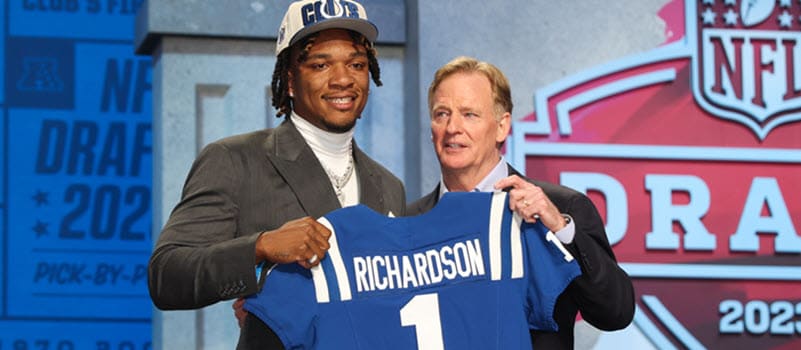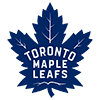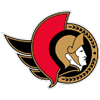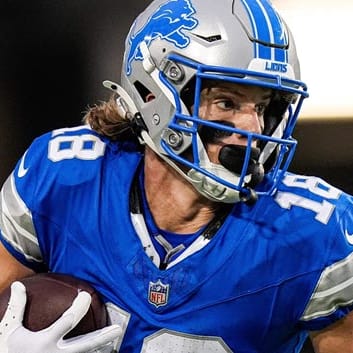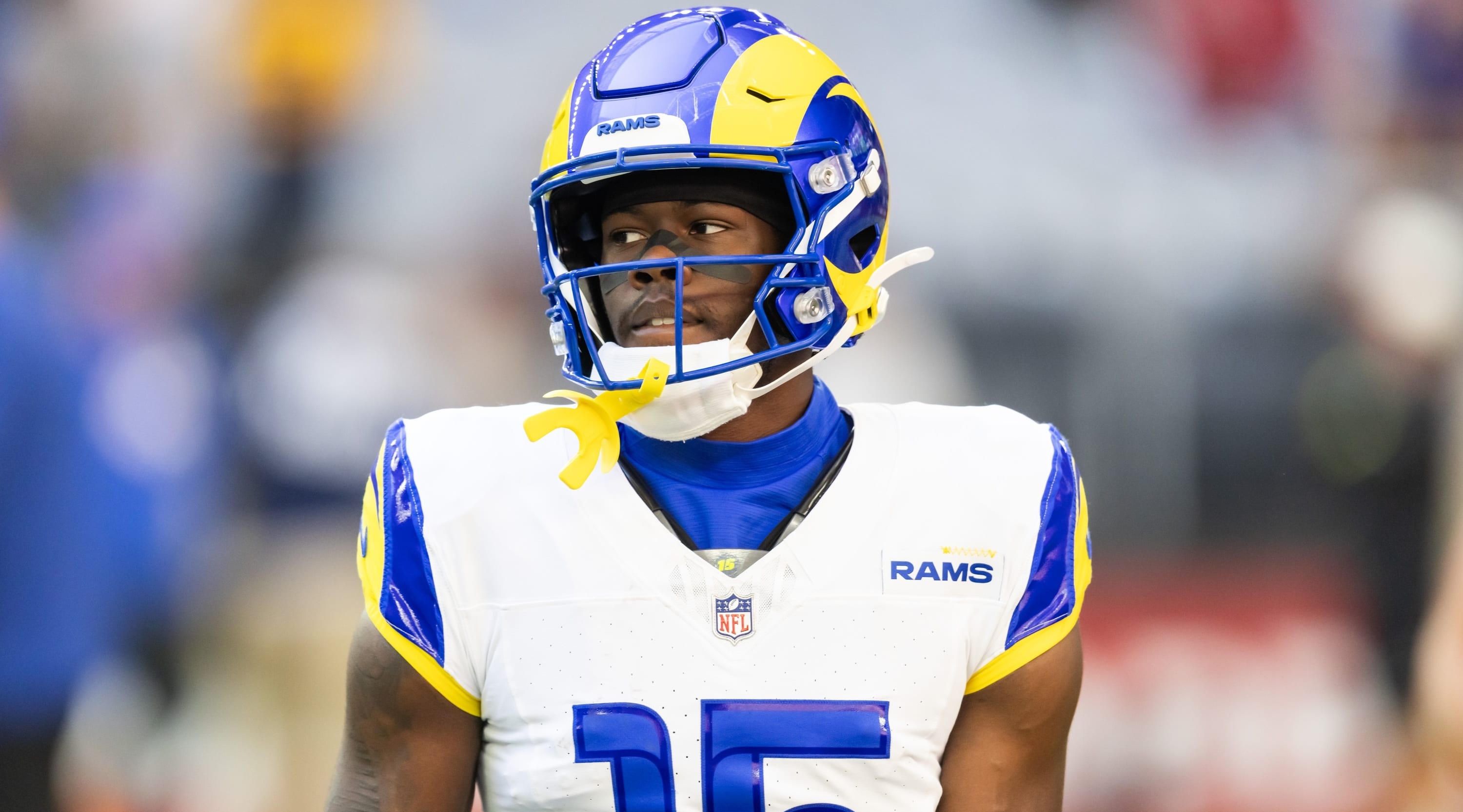After a fast start to the offseason with the Big Board and Little Board tournaments, Underdog Fantasy kept the momentum in the best ball scene by unveiling the Poodle ($7 entry), Best Ball Mania IV ($25), the Chow Chow ($50) and the Bulldog ($500) tournaments. Providing high-dollar payouts at the top winning spots for a variety of buy-in budgets, these big-field tournaments are a little different than the pre-NFL Draft 'Board' contests. This article will look at the emerging markets and look at four player examples to buy or fade at their new prices.
Sign up for Underdog to receive a free 6-month subscription to RotoWire and first deposit match up to $100 with Underdog promo code RWNFL. Claim this special offer now at https://play.underdogfantasy.com/pc-MyVn4cbt6l.
The biggest change from the Big Board-era tournaments is that this latest group of Underdog offerings are 18-round drafts, whereas the Big Board was a 20-round draft. The main result of that change might be that, with two fewer rounds to use, there's less room to capitalize on ambiguous situations/players at RB/WR in the final two rounds. The RBs and WRs in those rounds aren't hugely different from some of the players at those positions who go in rounds 17 and 18, so with 20 rounds it made more sense to aim for three quarterbacks than in the 18-round format, both because you had an extra spot to work with and because while there would be viable RB/WR targets in the final four rounds, the same would not be true at QB. You could acquire three starting quarterbacks, in other words, and not lose any meaningful edge at RB/WR to do it. Whereas in the 'Board contests projected starters like Jimmy Garoppolo (189.8 ADP), C.J. Stroud (191.1 ADP), Sam Howell (201.7 ADP), Desmond Ridder (205.9 ADP) and Mac Jones (209.6 ADP) tended to be gone by the end of the 16th round, at the moment all four players are going in the 16th or later.
It might be a case for both going 2QB rather than 3QB, and for going cheaper at QB2 in general. The elite QBs are still going high – Patrick Mahomes (19.2 ADP), Jalen Hurts (20.8 ADP), Josh Allen (22.5 ADP) and Lamar Jackson (31.7 ADP) are about as expensive as ever – with Jackson notably going about two full rounds earlier than he was during the 'Board days. Esteemed quarterbacks like Justin Fields (39.8 ADP), Joe Burrow (42.6 ADP), Justin Herbert (52.7 ADP) and Trevor Lawrence (62.6 ADP) all tend to be gone by the end of the fifth round, too. Despite the decreased demand for backup quarterbacks, the top tiers at the position have seen no price relief.
With the general changes noted, the following blurbs are four examples of players whose prices have shifted in May, as well as thoughts on whether they're worth the new price.
Anthony Richardson, QB, IND (89.1 ADP)
Few players have seen their ADP jump as much as Richardson's did in May, and now he's going earlier than he did even in the Superflex Big Board contest. Richardson would sometimes fall as far as the 14th round before the draft in the 1QB Big Board, so for him to be going in the eighth round of current drafts seems a little aggressive. I say that as a general Richardson proponent and someone who was drafting Richardson regularly in both the 1QB and Superflex Big Board drafts.
Shane Steichen is likely one of the league's top playcallers and quarterback coaches both, so with Jonathan Taylor drawing defensive attention there could be a way to keep Richardson's rookie-year tasks in a relatively low-difficulty setup. The problem with that scenario is that it would almost necessarily require low pass attempt volume for Richardson. Even the best rookie quarterbacks tend to struggle when their pass attempt volume gets too high – a simple matter of overexposure.
As Justin Fields demonstrated last year, it's possible for a quarterback to crush in fantasy on the strength of his rushing production, even if the passing production is lacking. That same narrow path exists for Richardson, but even Fields will be hard-pressed to maintain an average of 7.1 yards per carry over 160 attempts. Moreover, Fields played last year at 23 years old. Richardson just turned 21 in May, and will almost certainly be a better player in two years than he will be in 2023. Similarly, if Fields had played last year at 21 instead of 23 there's a strong chance that he would have been subjected to even more dysfunction.
Verdict: Dubious value
Nick Chubb, RB, CLE (19.5 ADP)
I'm not sure what changed, but Chubb is going a good amount earlier than he was a month ago. Chubb was at one point falling into the third round more often than not, which was the main subject of an article I posted in February (here). Perhaps there was an assumption that Chubb would see competition added in the draft, where the Browns instead drafted no one and at the moment have Jerome Ford (190.6 ADP) listed as the top backup. While it's true that Ford is generally not concerning to Chubb's workload, it's still a little early to assume the Browns are done at running back. It would be easy for them to sign someone like Ezekiel Elliott/Leonard Fournette or trade a late pick for Cordarrelle Patterson.
With that said, the actually correct assessment with Chubb is that he's still worth drafting at his present ADP even if the Browns add another notable running back. The Browns offense is likely to improve after Deshaun Watson has a full offseason working with the system, and Chubb for the first time might be the heir to a workhorse role in a good offense. Chubb is a candidate to lead the league rushing title in any given year, and if that occurs in the highest-scoring offense of his career then he could also lead the league in touchdowns from scrimmage.
Verdict: Good value
Devon Achane, RB, MIA (110.4 ADP)
Achane is a good prospect and landed with the best possible playcaller in Mike McDaniel, so it's understandable that there was some new enthusiasm for Achane after the Dolphins selected him in the third round. Since February I advocated Achane as a target (here) when his ADP was around the 150s, 140s and 130s, and even up to 120 or so. At 110, though, Achane is reaching the price point that makes even me somewhat concerned.
Achane's talent was underrated throughout the pre-draft process, but the concerns about workload limitations are almost certainly valid. Even if Achane goes into NFL training camp closer to 195 than 188, he's still unlikely to take many reps from Raheem Mostert (153.4 ADP) or Jeff Wilson (172.0 ADP) early on. The Dolphins called the second-fewest rush attempts in the NFL last year, so a workload split categorically limits Achane's upside.
The case for Achane over Mostert and Wilson relates to Achane's potential superiority as a big-play threat and pass catcher, allowing him to make the most with the least of the three, but that path to viability gets less convincing when Achane goes 40 picks higher than Mostert and 60 picks higher than Wilson. Whereas I was buying Achane in bulk from February to May, I'm probably out at the current price. Mostert is the Dolphins running back I'm targeting at current ADP.
Verdict: Dubious value
Jonathan Mingo, WR, CAR (126.4 ADP)
You can see the reasoning that Mingo buyers are following, figuring somewhat reasonably that Mingo must be (A) a generally good fantasy prospect and (B) third on the depth chart behind DJ Chark and Adam Thielen. Both (A) and (B) are probably not true.
Mingo projects as a good pro prospect in general but more so as a structural contributor than a from-scrimmage contributor. Mingo is a complementary target who can present a downfield jumpball target, forcing the defense to allocate some amount of speed toward his coverage, and one who can be a bully as a blocker if the defense gives up too much size to counter Mingo's vertical threat.
The catch with Mingo is that he's largely a bluff as a downfield threat. Mingo struggles to create separation downfield despite his 4.46 speed, relying instead on high-pointing the ball over a nearby defender. Mingo can beat you vertically if he's in single coverage against a corner who can't defend the rim, but in most other cases Mingo doesn't present an obvious edge as a route runner. While great athletic tools can sometimes be the basis for projected skill set growth, in Mingo's case it's a little concerning that he couldn't outproduce non-prospects like Malik Heath and Dontario Drummond despite possessing a major athletic advantage over them.
Indeed, when you examine Mingo's sum of traits and production what becomes immediately obvious is that this guy has almost nothing on Terrace Marshall (214.8 ADP). You can expect Chark to line up outside and Thielen primarily in the slot, meaning the remaining rep in most cases is a boundary one, and probably with routes with at least intermediate depth. Outside and intermediate/deep is the exact comfort zone for Marshall. Mingo would be a better option than Marshall in the slot, where Marshall struggles with the higher rate of collision, but it's doubtful either outdoes Thielen in the slot this year.
Expect Mingo to be the WR4 of an offense that ranks near the bottom of league passing production.
Verdict: Full fade


